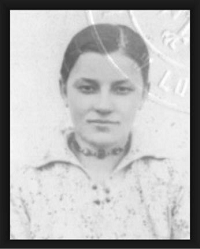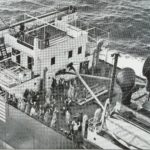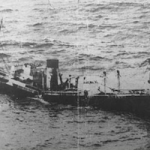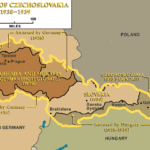Few experienced sailors have ever found themselves in the predicament that Spirydon Kucharczuk (koo-HAR-chuck) faced in the hours before dawn on the morning of Sept. 4, 1939. A Polish farmer immigrating to Canada with his family, Spirydon floated with his daughter on a piece of wreckage alone in the north Atlantic, 250 northwest of Ireland. (See blog post “Spirydon Kucharczuk, Part 3;” Feb. 15, 2016.)
The prospects for their rescue could not have appeared encouraging in those dark hours.
Spirydon, his wife and five children had been aboard the passenger ship Athenia when it was torpedoed by a German submarine shortly after sunset the previous evening. Although the oldest son had gone missing, the remaining six family members were able to leave the ship in the same lifeboat. Six hours later, as they waited to be taken aboard the Norwegian freighter Knute Nelson during rescue operations, their lifeboat was accidentally caught in the big ship’s propellers and chopped to pieces.
Amid the chaos of thrashing bodies in the water, Spirydon somehow found his oldest daughter, Neonela, but could not locate any other family members. Father and daughter struggled onto a small piece of wreckage from the lifeboat, but when other panicked survivors in the water threatened to swamp them, Spirydon managed to push himself and his daughter far beyond their reach, but also well beyond any chance of rescue.
Alone in the dark, cold ocean, worried about the fate of his wife and three youngest children, and with no means to signal for help, it’s hard to imagine what Spirydon must have been thinking.
The Kucharczuk family stories don’t include any comments from Spirydon or Neonela describing these events. As a result, there are no details of their miraculous rescue, most likely by one of the Royal Navy destroyers, Escort or Electra, which conducted a thorough search of the area after sunrise on the morning of Sept. 4.
In any case, they were returned to Glasgow, Scotland, and Neonela was hospitalized for several days while she recovered from her exposure to the elements. During this period, Spirydon was reunited with his son, Jan, who had been rescued by the Knute Nelson and taken to Galway, Ireland.
Jan later explained that he had seen a newspaper article in Galway that listed survivors taken to Glasgow, and it included the names “N. Kucharczuk” and “S. Kucharczuk.” He assumed S. Kucharczuk was his brother Stefan, who was a very good swimmer, and was surprised to learn that it was his father.
With a small Kucharczuk family nucleus thus reunited, Spirydon and his two oldest children anxiously awaited word of the rest of the family. Unfortunately, wartime communications restrictions and the fact that 236 survivors were bound for Halifax, Nova Scotia, caused agonizing delays in efforts to compile a definitive survivors list.
The story concludes in our next blog.





